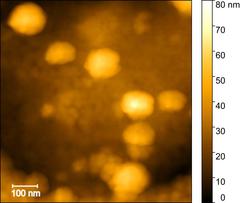URL: https://www.desy.de/news/news_search/index_eng.html
Breadcrumb Navigation
DESY News: Engineered wall paint could kill corona viruses
News
News from the DESY research centre
Engineered wall paint could kill corona viruses
Common wall paint could potentially be modified to kill the Corona virus and many other pathogens. This is an important finding of a study on the virus-killing effect of titanium dioxide (TiO2), a ubiquitous white pigment that is found in paints, plastic products and sunscreens. TiO2 also has many other important applications relevant to environmental sustainability and renewable energy. The international team led by Heshmat Noei from the DESY NanoLab reports its results in the journal Applied Materials & Interfaces published by the American Chemical Society (ACS).

An image taken with an atomic force microscope from the investigation: The SARS-CoV-2 particles (light) adsorb on the titanium dioxide surface. There, structural proteins are inactivated by denaturation and oxidation by light irradiation. Photo: DESY Nanolab, Mona Kohantorabi
Hard X-ray photoelectron spectroscopy at the PETRA III beamline P22 at DESY provides the necessary high chemical and elemental sensitivity to resolve subtle chemical changes. The research team investigated the contact process on the surface and was able to clarify that the amino acids of the corona virus spike protein attach to the titanium dioxide surface, trapping the virus and preventing it from binding to human cells. “We found that the virus adsorbs to the titanium dioxide surface and cannot detach again and will eventually be inactivated by dehydration and be denatured,” explains the paper´s main author Mona Kohantorabi from the DESY NanoLab. “Moreover, the titanium dioxide catalyses the inactivation of the virus by light. For our study we used ultraviolet light, which triggered the inactivation of the virus within 30 minutes, but we believe the catalyst can be further optimised to accelerate the inactivation and, more importantly, work under standard indoor lighting. We believe it could then be used as an antiviral coating for walls, windows and other surfaces for instance in hospitals, schools, airports, elderly homes and kindergartens.”
Theoretical calculations by the group of Cristina Di Valentin at the Università degli Studi di Milano-Bicocca confirmed that the amino acids of the spike protein interact with the TiO2 surface. Since these amino acids are present in the surface proteins of many other viruses, the NanoLab scientists expect the catalyst is also effective against several other viruses as well, but this needs to be tested. Most corona virus investigations look at liquid solutions. “But since corona and many other viruses spread through the air, it is important to look at aerosols,” says Noei. “If you create an antiviral coating, you have to put it where people are. Maybe you could even coat a fan to help purify the air.”
The team is now working on optimising the antiviral coating. “For instance, we found that the presence of palladium nanoparticles enhances the virus adsorption on the surface,” explains Kohantorabi. “Also, you want to avoid that water covers too much of the titanium dioxide surface, as less virus particles can be adsorbed.” Such coating must be able to fully regenerate and self-clean itself for improved longevity and sustainability in viral inactivation. The optimal mode of cleaning still needs to be determined. A complete oxidation of the virus on the surface would be a requirement for an efficient self-cleaning material. The team aims to test the optimised antiviral coating as soon as possible under conditions close to reality such as in hospitals.
Scientists from the University of Milan, Hamburg University of Technology, Technical University of Munich, Harvard Medical School, European Molecular Biology Laboratory, Leibniz Institute for Experimental Virology, Universität Hamburg, Helmholtz Munich and DESY have contributed to this study, which was supported by the initiative and networking fund of the Helmholtz Association of German Research Centers under the CORAERO Project (KA1-Co-06).
Reference
Adsorption and Inactivation of SARS-CoV-2 on the Surface of Anatase TiO2(101); Mona Kohantorabi, Michael Wagstaffe, Marcus Creutzburg, Aldo Ugolotti, Satishkumar Kulkarni, Arno Jeromin, Tobias Krekeler, Martin Feuerherd, Alexander Herrmann, Gregor Ebert, Ulrike Protzer, Gabriela Guédez, Christian Löw, Roland Thuenauer, Christoph Schlueter, Andrei Gloskovskii, Thomas F. Keller, Cristiana Di Valentin, Andreas Stierle, and Heshmat Noei; ACS Applied Materials & Interfaces, 2023; DOI: 10.1021/acsami.2c22078



